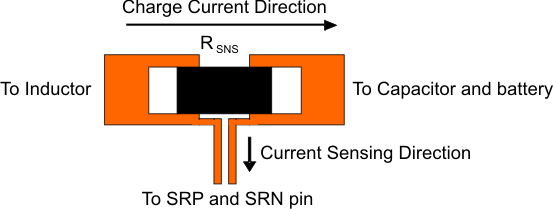SLUSCU2 November 2017
PRODUCTION DATA.
- 1 Features
- 2 Applications
- 3 Description
- 4 Revision History
- 5 Description (Continued)
- 6 Pin Configuration and Functions
- 7 Specifications
-
8 Detailed Description
- 8.1 Overview
- 8.2 Functional Block Diagram
- 8.3 Feature Description
- 8.4 Device Functional Modes
- 8.5 Programming
- 8.6
Register Map
- 8.6.1
Setting Charge and PROCHOT Options
- 8.6.1.1 ChargeOption0 Register (SMBus address = 12h) [reset = E20Eh]
- 8.6.1.2 ChargeOption1 Register (SMBus address = 30h) [reset = 211h]
- 8.6.1.3 ChargeOption2 Register (SMBus address = 31h) [reset = 2B7]
- 8.6.1.4 ChargeOption3 Register (SMBus address = 32h) [reset = 0h]
- 8.6.1.5 ProchotOption0 Register (SMBus address = 33h) [reset = 04A54h]
- 8.6.1.6 ProchotOption1 Register (SMBus address = 34h) [reset = 8120h]
- 8.6.1.7 ADCOption Register (SMBus address = 35h) [reset = 2000h]
- 8.6.2 Charge and PROCHOT Status
- 8.6.3 ChargeCurrent Register (SMBus address = 14h) [reset = 0h]
- 8.6.4 MaxChargeVoltage Register (SMBus address = 15h) [reset value based on CELL_BATPRESZ pin setting]
- 8.6.5 MinSystemVoltage Register (SMBus address = 3Eh) [reset value based on CELL_BATPRESZ pin setting]
- 8.6.6 Input Current and Input Voltage Registers for Dynamic Power Management
- 8.6.7 ADCVBUS/PSYS Register (SMBus address = 23h)
- 8.6.8 ADCIBAT Register (SMBus address = 24h)
- 8.6.9 ADCIINCMPIN Register (SMBus address = 25h)
- 8.6.10 ADCVSYSVBAT Register (SMBus address = 26h) (reset = )
- 8.6.11 ID Registers
- 8.6.1
Setting Charge and PROCHOT Options
- 9 Application and Implementation
- 10Power Supply Recommendations
- 11Layout
- 12Device and Documentation Support
- 13Mechanical, Packaging, and Orderable Information
11 Layout
11.1 Layout Guidelines
The switching node rise and fall times should be minimized for minimum switching loss. Proper layout of the components to minimize high frequency current path loop (see Layout Example section) is important to prevent electrical and magnetic field radiation and high frequency resonant problems. Here is a PCB layout priority list for proper layout. Layout PCB according to this specific order is essential.
- Place the input capacitor as close as possible to the supply of the switching MOSFET and ground connections. Use a short copper trace connection. These parts must be placed on the same layer of PCB using vias to make this connection.
- The device must be placed close to the gate pins of the switching MOSFET. Keep the gate drive signal traces short for a clean MOSFET drive. The device can be placed on the other side of the PCB of switching MOSFETs.
- Place an inductor input pin as close as possible to the output pin of the switching MOSFET. Minimize the copper area of this trace to lower electrical and magnetic field radiation but make the trace wide enough to carry the charging current. Do not use multiple layers in parallel for this connection. Minimize parasitic capacitance from this area to any other trace or plane.
- The charging current sensing resistor should be placed right next to the inductor output. Route the sense leads connected across the sensing resistor back to the device in same layer, close to each other (minimize loop area) and do not route the sense leads through a high-current path (see Figure 50 for Kelvin connection for best current accuracy). Place a decoupling capacitor on these traces next to the device.
- Place an output capacitor next to the sensing resistor output and ground.
- Output capacitor ground connections must be tied to the same copper that connects to the input capacitor ground before connecting to system ground.
- Use a single ground connection to tie the charger power ground to the charger analog ground. Just beneath the device, use analog ground copper pour but avoid power pins to reduce inductive and capacitive noise coupling.
- Route analog ground separately from power ground. Connect analog ground and connect power ground separately. Connect analog ground and power ground together using power pad as the single ground connection point. Or using a 0-Ω resistor to tie analog ground to power ground (power pad should tie to analog ground in this case if possible).
- Decoupling capacitors must be placed next to the device pins. Make trace connection as short as possible.
- It is critical that the exposed power pad on the backside of the device package be soldered to the PCB ground.
- The via size and number should be enough for a given current path. See the EVM design (SLUUBG6) for the recommended component placement with trace and via locations. For the WQFN information, see SLUA271.
11.2 Layout Example
11.2.1 Layout Consideration of Current Path
 Figure 49. High Frequency Current Path
Figure 49. High Frequency Current Path
11.2.2 Layout Consideration of Short Circuit Protection
 Figure 50. Sensing Resistor PCB Layout
Figure 50. Sensing Resistor PCB Layout